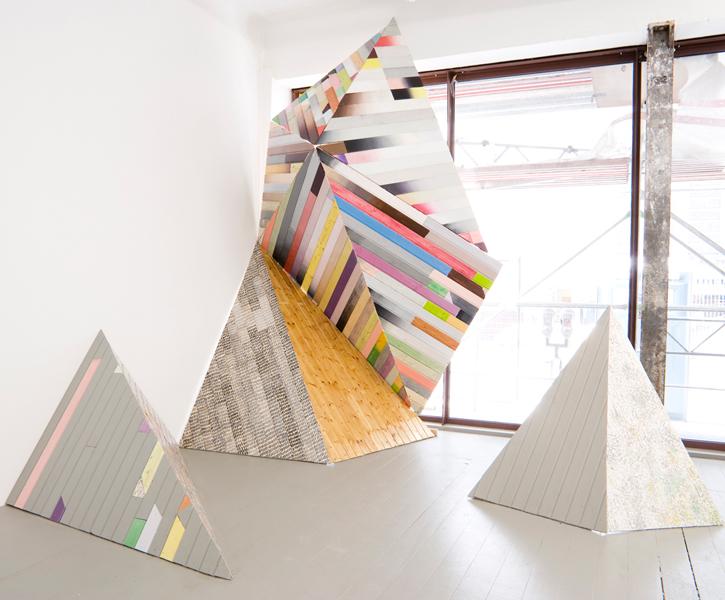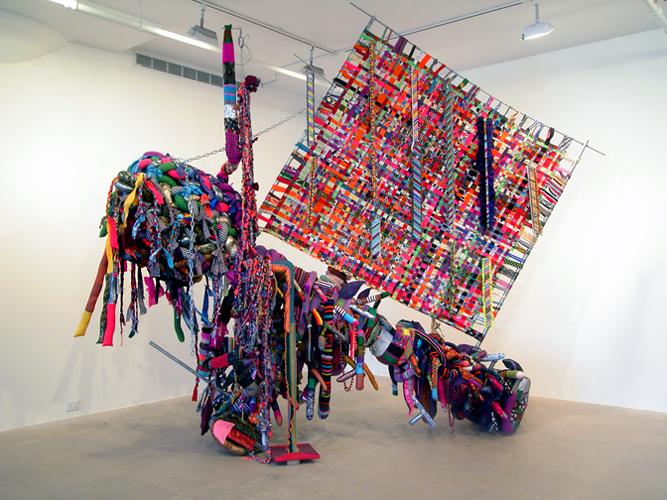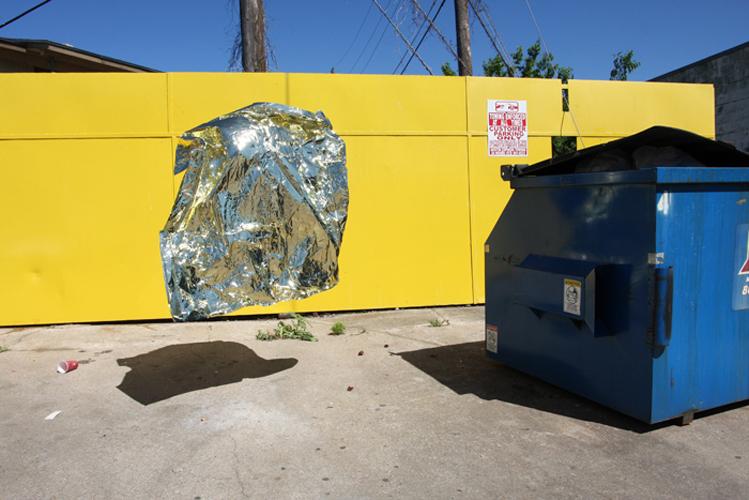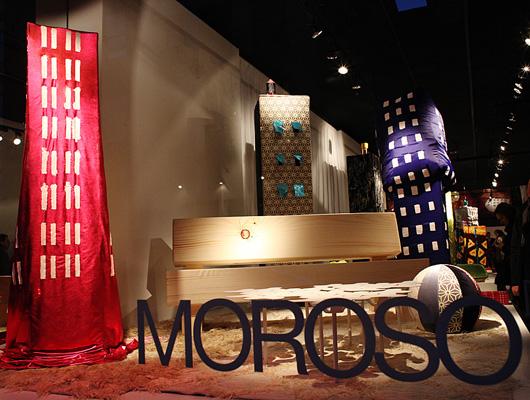
03.07.11
Q+A
Patrizia Moroso, Design Producer, and Anna Galtarossa, Artist
SHOP INSTALLATION PHOTOS BY KRAMER O’NEILL
It gyrates, it whirs, and it’s every bit the mechanically-powered spectacle of a department-store Christmas Village: Italian furniture brand Moroso’s New York showroom has been transformed into a jolly urban landscape of brightly colored kinetic skyscrapers, an immersive installation created by the young Italian artist Anna Galtarossa. Woven amongst the shop’s Tord Boontje lounge chairs and Front sofas, Galtarossa’s fabric buildings were commissioned by company founder Patrizia Moroso as part of a newly launched grant project called the Moroso Award for Contemporary Art. Curated in partnership with the Civic Gallery of Contemporary Art in Monfalcone — along with a guest panel of design-industry talents like Tobias Rehberger, David Adjaye, and Patricia Urquiola — the award will fund not only Galtarossa’s New York project but planned installations by additional 2011 recipients Martino Gamper and Christian Frosi. But even more, it serves Moroso’s own effort to expand her support to art, a creative discipline that has lost crucial government funding in recent years, by highlighting its potential to impact the practice of design. We recently spoke with both Moroso and Galtarossa about the ways art and design can influence one another, and how Galtarossa’s Skyscraper Nursery embodies those ideas.
Anna, what was your experience with the design world before you started this project?
Anna Galtarossa: I always felt influenced by design just by virtue of living in Italy. You absorb it passively and you don’t even know it. I literally don’t know it — I don’t know anything about design, so to me it’s a challenge and it’s an inspiration at the same time. Maybe it’s easier and fresher not knowing about design, because I approach it in a very instinctual way; I relate directly to the materials and colors and shapes. I know nothing about production or drawing, I just see something as an object, and everything is a sculpture to me.
Patrizia Moroso: Our intention isn’t to mix design and art, but to keep them as they are and to get them talking to each other. They have to be different, otherwise they don’t need to talk. She’s not making design — she’s totally an artist, and she’s playing with the objects around her, and they’re all in a kind of dialogue.
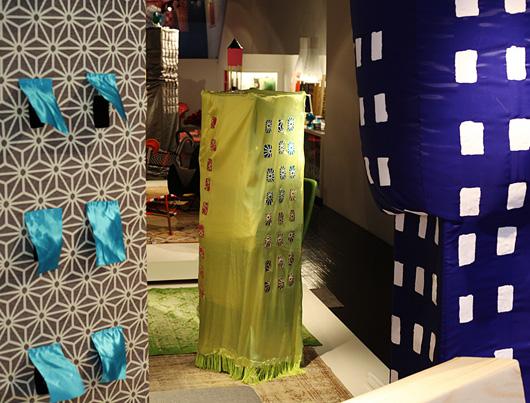
Patrizia, what are the qualities of Anna’s work that think are particularly well suited to the designs you produce?
PM: She’s really joyful in her work, and she has an energetic quality that I identify with. I choose designers that have that same kind of energy, and a love for making new, colorful pieces rather than always using black leather or chrome. I want to make objects with a soul inside, that express emotions and move people. Function, okay — we let it in, and we know there has to be one. But we’re looking for something more, and that’s the part of our work that relates to Anna’s.
AG: Emotional connetion is so important to my work. There are artists who don’t care what people think, but it’s important to me that I be generous. I don’t want to withdraw from dialogues and exchanges. I open my work up to be enjoyed from the first minute you see it. You can dig deeper and find more layers, but you don’t need to if you don’t want to. My sculptures have to give you something right away, and so does Moroso’s furniture — you don’t have to be a design intellectual to love it.
Anna, what inspired you to create this particular installation?
AG: I’ve always been fascinated by skyscrapers because I grew up between the countryside and the mountains, so I saw my first skyscraper when I was maybe 10. Wow, they’re so magical. I don’t know how we could have built them as human beings; we’re so small, it’s not possible. So that made me think that maybe they’re born small and then they grow. I thought, let’s help the real estate crisis, let’s make some skyscrapers, and maybe they’ll grow! At first they’re babies and they can’t stand still, so that’s the main reason why my skyscrapers move.
I’ve also been so influenced by New York City and its galvanizing energy. I’m acting as a mirror, because I don’t think New Yorkers always know what they project to the rest of the world. It’s nice to show them what they mean to us foreigners. This project is an homage to that energy.
In terms of materiality, how does the project relate to your past work?
AG: I’ve always worked with all these materials that have to do with femininity. To me it’s always been a struggle to be a girl. I’m a tomboy, and my mom is a bit of a tomboy in a way — nobody taught me to put lipstick on, or to sew, or to wash dishes. Of course! Who’s going to teach girls to wash dishes these days? But it’s kind of a pity that we forget how to sew, for example, or to knit — basic things that have been part of our DNA for so many milennia. They don’t make sense anymore like they used to, so I’m trying to find new meanings for these ancestral actions.
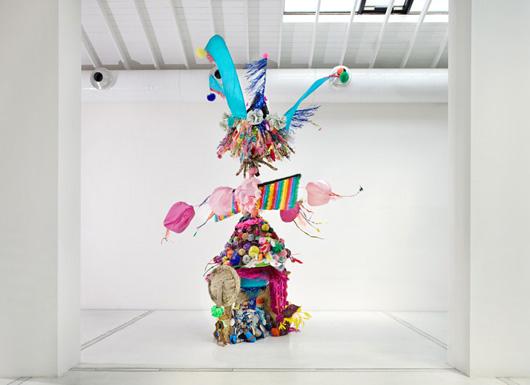
Galtarossa’s “Totem,” a 2010 sculpture built atop a cement mixture that spins “like a Whirling Dervish,” says the artist.
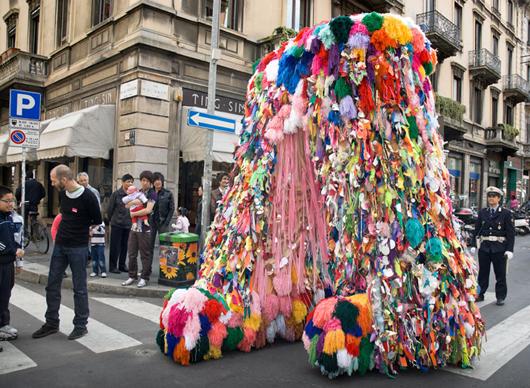
Galtarossa’s 2008 “Monster of Castelvecchio,” a commission from Verona’s history museum, took a walk through the city’s main street each evening by way of two young men hidden inside its elaborate shell.
Did you take any direct inspiration from Moroso’s furniture?
AG: I used their fabrics. Not all of them — the more kitsch fabrics are not Moroso — but they did send me quite a bit of fabric to work with, and even that was quite inspiring. I’d like to keep using them. I also went to visit the factory, and I had so many ideas for works based on their process. Even the things you don’t see, like the structures before they’re upholstered, and the way they do the padding, and the prototypes. It’s amazing.
So participating in this project has actually influenced your practice?
AG: Definitely. I hope I can explore these materials and methods more. I did make a fridge in the past: It was called King Kong Cave, and it was a mountain of fake plants and sequins and all sorts of things that these plants vomit, and then you’d look for a handle and open it and inside it was an actual fridge. It was for the PlusDesign shop in Milan. I’m not a designer, so I wasn’t going to design, draw, and produce something. So I used the same dynamics I use in my work, the way I built a totem around a cement mixer: I just took a fridge and turned it into something else. I wouldn’t call that design.
PM: Before this project Anna had also created two beautiful objects starting from a piece of design, for the show “Basic Human Impulse” last May at the Civic Gallery. We have a piece made in 1988 by Toshiyuki Kita called Monkey’s Mountain, and it follows the typical Japanese thinking about organic design. His idea was that the same way you see little monkeys sitting on a rock, humans can lay, sit, sleep, or even do yoga on this chair. There are so many different ways of sitting, and when we’re in a space without a chair at all, we choose our own way. So this reminds us of how we react when we have no chair but only a piece of nature, a rock. Anna saw Kita’s chair in the factory and wanted to work on it, so she dressed his mountain full of sequins, flowers, and pieces of fabric.
AG: I hope the designer never sees it!
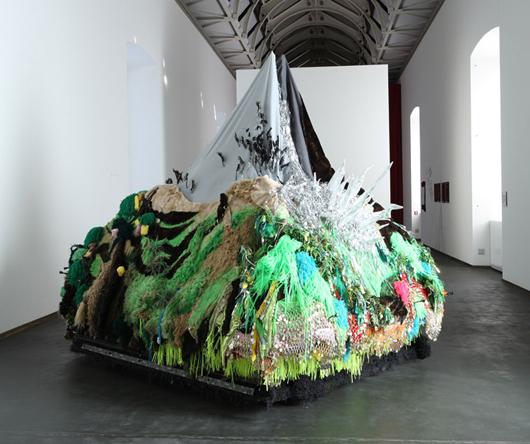
One of Galtarossa’s inspirations for the Kita redux was this earlier work of hers, “Aconcagua” (2008): a kinetic mountain covered in faux fur, jewels, mylar, fabric, wool, fishnet stockings, and hair rollers.
PM: That exhibition, like this one, was looking for a relationship between art and design. But in that case the artists were reacting directly to the designs, asking themselves what can I do with this object. Everyone was totally free to do what they wanted, so some of them worked on the objects, and others forgot the objects entirely. One young Austrian artist, after a day of looking around our factory, asked if we had 10 rolls of packing tape, and in the gallery he did an incredibly beautiful thing using the tape like a spiderweb. I think that putting artists closer to design can give us another perspective on what we’re doing — they’re helping us think about our work in a different way.
I remember in the ’60s and ’70s, in the beginning of the big adventure of design, design was a revolutionary tool, and designers were all thinking about changing the world. It was a very important time, with a utopian way of thinking. In that moment, design, art, and architecture were all very close to each other. Then design became a business, something to sell rather than something to change. But I try to keep that memory from Italian design in the ’60s, when I was a kid and design was changing our lives. We should never forget that moment. If you’re not changing things, why are you designing? Everything already exists — we already have very good sofas and very good chairs. We don’t need more of the same.
AG: You can replace design with art in that thinking and it works exactly the same. I really struggle to find that kind of energy myself. So maybe that’s why Patrizia and I feel so happy together, because I’m always dreaming of that type of utopian energy.
